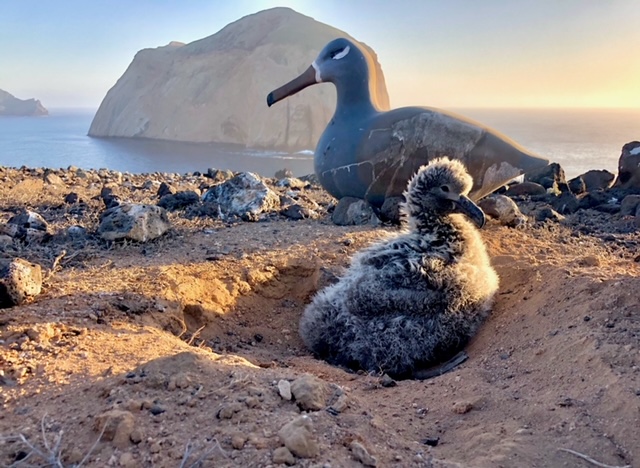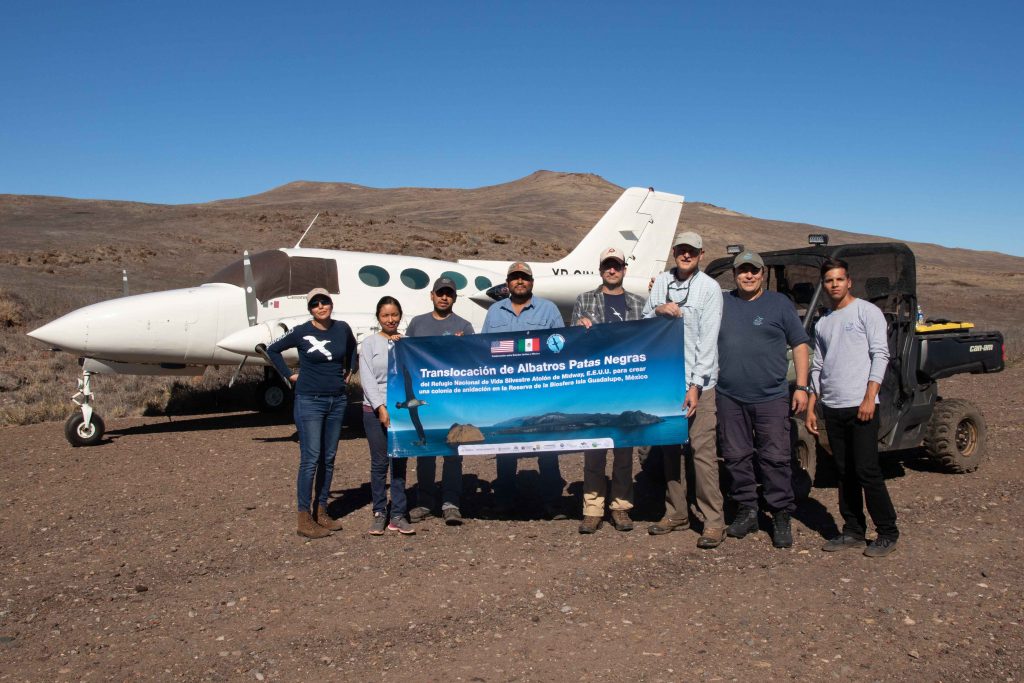Mexico and US Work Together to Conserve Threatened Black-Footed Albatross
The US Fish and Wildlife Service and Pacific Rim Conservation joined with the Mexican government and a Mexican conservation group to launch a long-term conservation project to protect the black-footed albatross, a threatened seabird species.
The project is working to reestablish a once-thriving breeding colony on Guadalupe Island in Mexico with eggs relocated from the Midway Atoll National Refuge in the United States. Due to rising seas and other issues of climate change, the seabirds will have a better longterm chance of surviving on the higher-elevation Guadalupe Island than the low-lying refuge.
It is one of the few international translocations conducted between the United States and Mexico. The countries also worked together previously to protect the Mexican Gray Wolf and California Condor.
The black-footed albatross colony on Guadalupe Island was destroyed more than two decades ago due to predation of introduced feral cats. Since 2000, Mexican biologists have recorded numerous sightings on the island and in surrounding waters, but no nesting.
The black-footed albatross is considered a Near Threatened species by the
International Union for Conservation of Nature and Threatened by the Mexican Official Standard. It is also included in the list of species and populations of conservation priority for Mexico.
The current main threats to this species are incidental mortality of adults due to fisheries bycatch; loss of nesting colonies due to flooding from sea level rise and increased storm surge associated with global climate change; death of individuals from ingestion of plastic and other pollutants; and introduction of invasive alien predators to their breeding islands.
Flooding of nesting colonies is the most serious long-term threat because 95 percent of the world’s population nests on low-lying atolls in Hawaiʻi that have elevations of only a few feet.
The U.S.-Mexico binational black-footed albatross reintroduction project, which includes Mexico’s Comisión Nacional de Áreas Naturales
Protegidas and Grupo de Ecología y Conservación de Islas, seeks to also strengthen the species’ resilience to the impacts of climate change.
Re-establishing this nesting colony of the black-footed albatross in the eastern Pacific would increase the breeding range for the species and increase the diversity of environments occupied by the species, thus providing greater resilience and potential for adaptation.
Guadalupe Island is located 161 miles off the west coast of Baja California, Mexico. It is a large island (151 miles squared), with altitudes reaching 4,258 feet above sea level, and offers excellent conditions for the project for several reasons:
- It is a Natural Protected Area under the category of Biosphere Reserve, actively managed by the Mexican government. And due to the restoration actions implemented for more than 15 years, it is already an important breeding site for six species of seabirds, including the Laysan albatross (Phoebastria immutabilis).
- Feral cats have been removed from the island and are no longer a threat.
- The cold waters of the California current around Guadalupe Island are ideal foraging habitat for albatrosses, and tracking studies have shown that some albatrosses that nest in Hawaii commute to this area to feed.
Reintroduction of the black-footed albatross is being carried out through the transfer of eggs and chicks from Midway Atoll National Wildlife Refuge to the Guadalupe Island Biosphere Reserve. The techniques used in the project are based on the most up-to-date ethical and scientific standards developed and adapted by Pacific Rim Conservation during previous similar projects in the Hawaiian Islands. The black-footed albatross eggs will be cross-fostered into Laysan albatross nests, and the chicks will be hand-raised.
To minimize any impacts to the source population on Midway, the eggs and chicks were collected from nests next to the ocean, where they were at risk of being washed away by high waves.
The reintroduction is complemented by the conservation and restoration work carried out in the Guadalupe Island Biosphere Reserve, which has resulted in a robust nesting colony of Laysan Albatross due to the control of invasive exotic species that threatened the native fauna and the colonies, and the effective actions of social attraction to promote nesting, and finally to the monitoring actions of the population and individuals in the nesting colony.
In January, the project began with the first 21 eggs flown from Midway Atoll National Wildlife Refuge to Guadalupe Island. The eggs were placed in foster nests of Laysan albatrosses in which the natural egg was infertile. In early February, 18 of the 21 eggs hatched, representing an 86 percent hatching success rate, similar to the rate in natural Laysan albatross nests on Guadalupe and in other inter-island translocation projects in Hawaiʻi.
On February 18, 9 black-footed albatross chicks were imported from Midway Atoll National Wildlife Refuge and arrived in Mexico and were successfully released in the Guadalupe Island Biosphere Reserve, where they will be raised by a team of biologists and veterinarians. The 27 Black-footed albatross chicks are expected to fledge from Guadalupe Island in June.
Because black-footed albatrosses are faithful to the place where they hatched or were raised from a young age (philopatric), it is expected that this generation of chicks will return to nest on Guadalupe when they are mature.
The reintroduction of black-footed albatrosses is a long-term project because albatrosses are long-lived; they will spend their first few years at sea continuously and are expected to begin returning to Guadalupe in 3 to 5 years and to begin nesting there in 8-9 years.
In 2022 and 2023, the binational team aims to move up to 42 eggs and 25 chicks per year in order to have at least 100 individuals to form the new breeding colony on Guadalupe Island.
This project is part of the Pacific Rim Conservation’s www.islandarks.org initiative that was started on Oʻahu at James Campbell National Wildlife Refuge.
















